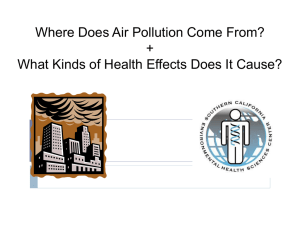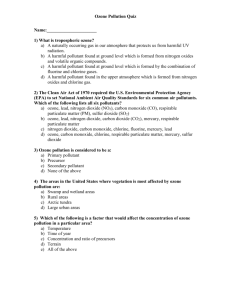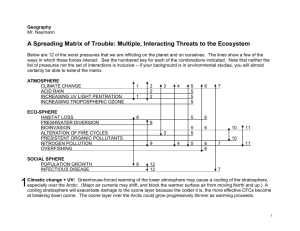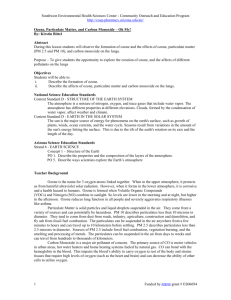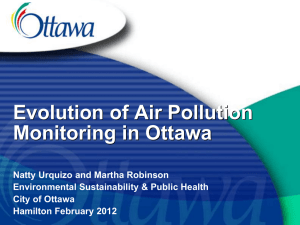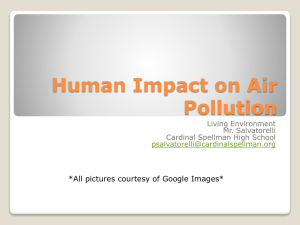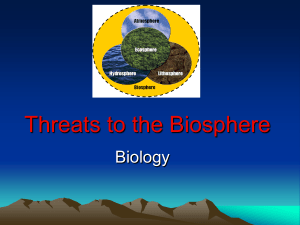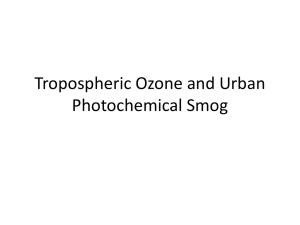Satellite & Ground Based Environment Monitoring by Dr
advertisement
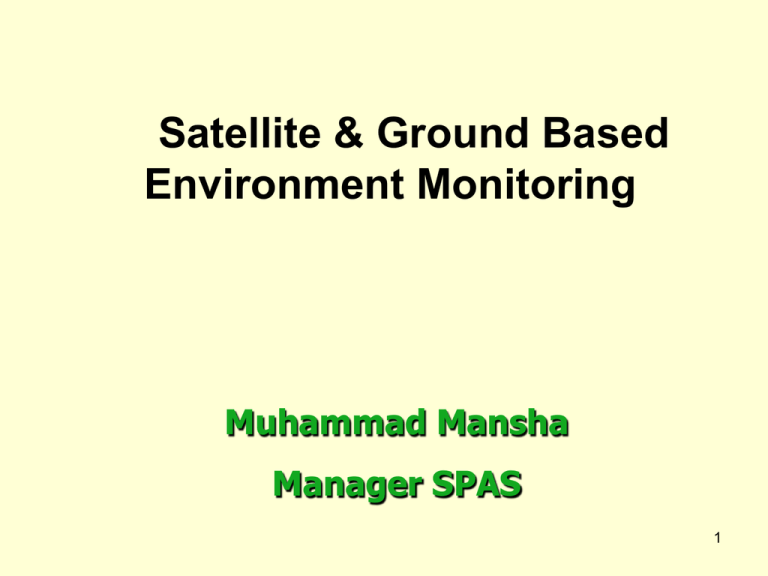
Satellite & Ground Based Environment Monitoring Muhammad Mansha Manager SPAS 1 What is Environment? Atmosphere ENVIRONMENT LAND WATER Environment Monitoring Methods Ground-based Sampling and Measurements Model-based Monitoring Satellite based Monitoring 4 Pollution Harboring Pollution Air Water Land Noise Pollution: production of unwanted sounds that are annoying, distracting or damaging to one’s hearing. 5 Air Pollution Air pollution is the introduction of chemicals, particulate matter, or biological materials that cause harm or discomfort to humans or other living organisms, or damages the natural environment into the atmosphere ASSESSMENT TECHNIQUES • Direct Monitoring • Mathematical Modeling 9 Direct Monitoring Techniques Electrochemical analysis Absorption spectroscopy ICP emission spectroscopy Ion chromatography Liquid chromatography. Gas chromatography. Mass Spectrometry Biological Monitoring of pollutants. 10 Monitoring NO2 • Chemiluminescence Method • Christie Arsenite Method • Diffusion Tube Method • Differential Optical Absorption • Spectroscopy Method 11 Nitrogen dioxide NO2 Chemiluminescence Method Method: Concentrations of nitrogen dioxide (NO2) in ambient air are determined by photometrically measuring the light intensity, at wavelenghts greater than 600 nm, resulting from the chemiluminescent reaction of nitric oxide (NO) with ozone (o3). NO2 is first quantitatively reduced to NO by a converter. The NO, which commonly exist in association with NO2, passes through the converter unchanged, resulting in a total nitrogen oxide (NOx) concentration of NO plus NO2. A Portion of the ambient air is also reacted with O3 without having passes through the converter, and the NO concentration is measured. This value is subtracted from the NOx concentration yielding the concentration of NO2. The analyzer actually measures the NO concentration of air. This is determined by measuring the light emitted when NO is reacted with O3 (The O3 generated within the Instrument). 12 Ozone is also measured by these methods • Chemiluminescence's Method • Optical Absorption Spectroscopy Method • Infra-red Absorption Method and • Electrochemical Cell Method. 13 Particulates Matter Beta-Gauge Method Particulate matter is collected on high efficiency glass fiber filter tape, through which the sample air is drawn. The filter tape runs between a radioactive source (emitting B radiation ) and a detection device. The mass of particulate is estimated from the observed absorption of B – radiation. Smoke Shade Reflections Method Particulate matter is collected by drawing air through a filter. The concentration is then inferred from the light reflectance of the darkened filter. The method is not strictly a measure of total suspended particulates. It actually measures ‘ smoke’ and indicate elemental carbon content of air. 14 Total Suspended Particulates Hi-Volume Sample Method Particulate matter is collected by drawing air through a filter. The mass concentration of TSP in the ambient air is computed as the total mass of collected particles divided by the volume of air sample, and is expressed in micrograms per cubic meter. TSP= (Wf-Wi)106 =ug/m3 V V = Qact x (24Hours) 60 min/hr Qact = Initial flow rate= Final flow rate 2 Sampling Period: The Sampling Period is 24 hours. Interference : Interference can occur from gases 15 High Volume Sampler BASIC COMPONENTS OF SYSTEM FILTER HOLDER DIGITAL TIMER PROGRAMMER/FLOW CONTROLLER BLOWER MOTOR FLOW METER 16 Carbon Monoxide (CO) CO is Colorless, odorless gas. Formed when carbon fuel is not burned completely. Contributes to the formation of ground-level ozone • Toxic to all humans and animals. CO binds to hemoglobin in place of oxygen Affinity for CO ~ 200x higher than for O2 which result in: • risk of heart attacks • brain damage, unconsciousness etc. Sources • The major source of atmospheric CO is the spark ignition combustion engine especially under idling and deceleration conditions. • Smaller contributions from all other processes involving the combustion of organic matter (in power stations, industry, waste incineration). 17 Sulfur Dioxide (SO2) Characteristics: A colorless gas with a strong, suffocating odor. Health effects: Throat and lung irritation, swelling and accumulation of fluid in throat and lungs or nasal bleeding. Contributes: It is a major component of acid rain, acidic aerosol or acidic fog Major Sources: It comes from the burning of coal and oil, Coal-burning stoves Power plants, Industries, Refineries and Vehicles 18 Nitrogen Oxides (NOx) Characteristics: A poisonous, reddish-brown to dark brown gas with an irritating odor Health Effects: Nose and throat irritation, coughing, choking, headache, nausea, stomach or chest pains and lung inflammation such as bronchitis or pneumonia. Contributes: Play a major role in the formation of ozone, PM, haze and acid rain, Important component of photochemical smog, Forms from combustion at high temperatures Major Sources Mobile – Automobiles, Stationary – Power plants, home heaters, gas stoves, Formation reduced by low-temperature combustion 19 Ozone Where can it be found? • • Stratosphere - protects us from UV rays of the sun “good” ozone Troposphere - ground-level ozone - the air we breathe - “bad” ozone Sources: • • • • Most of the O3 in the troposphere is formed indirectly by the action of sunlight on nitrogen dioxide Air emissions from industry Motor vehicle exhaust Gasoline vapors Chemical solvents 20 Ozone (O3) Impacts Ozone and other oxidants cause a range of acute effects including: Health • • • Eye, nose and throat irritation Chest discomfort, cough and headache Respiratory inflammation Environment • • • Significant reduction in plant growth Causes crop loss each year Damage to forest ecosystems and materials 21 Inhalable Particulates (PM10 & PM2.5) • Characteristics: A broad class of chemically and physically diverse substances that exist as particles with a diameter less than or equal to 2.5 microns. • Characteristics: A broad class of chemically and physically diverse substances that exist as particles with a diameter less than or equal to 10 microns. • Health Effects: Inhalation of particulates increases chronic and acute respiratory illnesses. PM10 PM2.5 22 Particulate Matter Major Sources • • • • • • Diesel engines Power plants Industrial processes & incinerators Windblown dust Wood stoves Other sources 23 SMOG • Particulates (Especially Lead) • Nitrous Oxides • Potassium • Carbon Monoxide • Other toxic chemicals 24 Effects of Air Pollution Effects on human health Acute effects Chronic effects Effects on natural environment Acid rain Ozone layer depletion Global warming Global climate change 25 Effects of Air Pollution Ecosystems Reduction of visibility Global warming Health: Irritation and inflammation Breathing difficulties Lung damage Heart disease Vision problems Premature death 26 Effects of Air Pollution • • • • Acid rain Ozone depletion Global warming In human populationrespiratory problems, allergies, strengthens lugs, and a risk for cancer 27 ACID RAIN • Contains high levels of sulfuric or nitric acids • Contaminate drinking water and vegetation • Damage aquatic life • Erode buildings • Alters the chemical equilibrium of some soils Effects on trees Effects on leaves Effects on stonework 28 29 30 Classification of Emission Sources • Natural Sources • Anthropogenic sources • Stationary (power plants, incinerators, industrial operations, and space heating) Sources • Moving (motor vehicles, ships, aircraft, and rockets) sources • Point (a single stack) Sources • Line (a line of stacks) Sources • Area (city) Sources • Volume Sources • Open Pit Sources 31 Modeling Technique Air Quality modeling is the mathematical prediction of ambient concentrations of air pollution, based on measured inputs • Modeling for air quality management purposes typically falls into two broad categories :dispersion modeling and receptor-based modeling ( 32 Water Pollution Water is a compound of hydrogen and oxygen. In its pure form, water is tasteless, colorless and odorless. Water pollution is the presence in water of enough harmful or objectionable material to damage water quality Water quality measurement There are two broad measures of water quality: • Oxygen levels or demands in the water, and • Concentration of heavy metals Water Pollution – Seepage into ground water from nonpoint sources – The loss of habitats such as wetlands – we cannot always eat what we catch because fish flesh is contaminated by the remaining discharges and sources of toxic substances – Microbial contamination of drinking water presents problems in many communities still 34 Land Pollution • Land is any part of the earth’s surface not covered by a body of water (terrestrial biosphere). It is used by human beings to grow food, rear animals, build shelter • Improper handling commercial wastes, effluents of human, household and and contamination industrial Ground based Measuring Instruments • Particulate Matter (TSP, PM10,PM2.5) • Carbon dioxide (CO2) • Carbon monoxide (CO) • Oxides of Sulfur (SOX) • Hydrogen Sulfide (H2S) • Oxides of Nitrogen (NOX) • Ground level Ozone (O3) • Volatile Organic Compounds (VOCs) •Asbestos Fibre Count Facilities Ground based Analytical Measurements Environment Monitoring Satellites Geostationary Satellites Polar Satellites • MTSAT • Meteosat • FENGYUN (2C) • • • • • NOAA-15,16,17,18 AQUA TERRA FENGYUN (1D) Orbview Moderate Resolution Imaging Spectro-radiometer (MODIS) onboard AQUA & TERRA Satellites 39 Satellite Based Environment Monitoring Areas • • • • • • • • Atmosphere Monitoring Air Quality Monitoring Climate Change Studies Resource Management Glaciers and Snow Drought Landuse / Landcover • • • • • • • Weather Prediction Hazards Monitoring Aviation Agriculture Marine & Phytoplankton Studies SST/LST Dust Storm Carbon Sink Study 40 Satellite Based Monitoring Facilities AERONET - SUN PHOTOMETER A View of Aeronet Site - Karachi A View of Data Logger Water Vapor (cm) Aerosol Optical Thickness Size Distribution Fog/Haze study through Satellite 44 Total Ozone through Satellite 5km pixels Day and night passes Range: 0 du to 500 du Applications Ozone studies Indicative of climate conditions Used as inputs to other level-2+ products 45 Drought Monitoring Healthy vegetations strongly absorb visible radiation (from 0.4 to 0.7 um) and strongly reflect near infrared radiation (from 0.7 to 1.1 um) Say: Have ye thought: If (all) your water were to disappear into the earth, who then could bring you gushing water ? (Al -Mulk -30 ) Thank You
